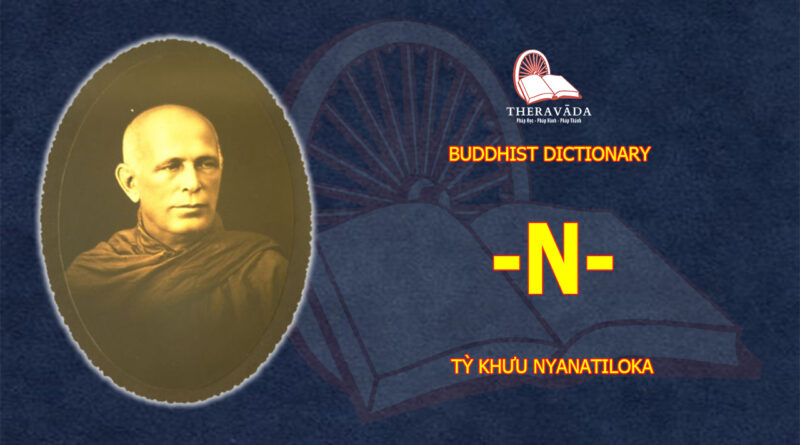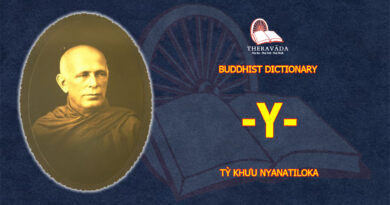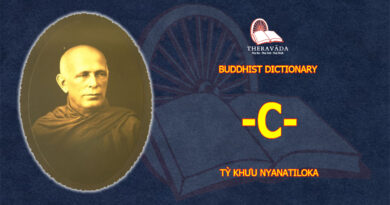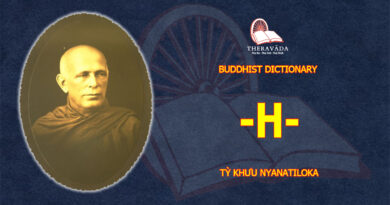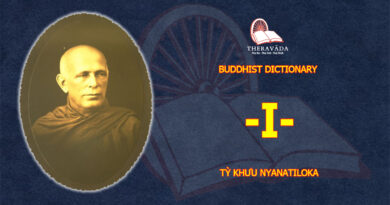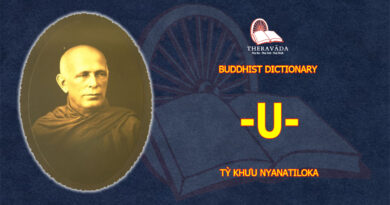BUDDHIST DICTIONARY
-N-
nāma: (lit. ‘name’): ‘mind’, mentality. This term is generally used as a collective name for the 4 mental groups (arūpino khandha), viz. feeling (vedanā), perception (saññā), mental formations (saṅkhāra) and consciousness (viññāṇa). Within the 4th link (nāma-rūpa) in the formula of the paṭiccasamuppāda (q.v.), however, it applies only to kamma-resultant (vipāka) feeling and perception and a few kamma-resultant mental functions inseparable from any consciousness. As it is said (M. 9; D. 15; S. XII, 2): “Feeling (vedanā), perception (saññā), volition (cetanā), impression (phassa), mental advertence (manasikāra): this, o brother, is called mind (nāma).” With the addition of 2 more mental factors, namely, mental vitality (jīvita) and concentration (samādhi), here ‘stationary phase of mind’ (cittaṭṭhiti), these 7 factors are said in the Abhidhammatthasaṅgaha to be the inseparable mental factors in any state of consciousness.
For the complete list of all the 50 mental formations of the saṅkhāra-kkhandha (not including feeling and perception), s. Tab. II.
nāma-kāya: the ‘mind-group’ (as distinguished from rūpa-kāya, the corporeality-group) comprises the 4 immaterial groups of existence (arūpino khandhā; s. khandha). This twofold grouping, frequent in Com., occurs first in D. 15, also in Pts.M. (I, 183); nāma-kāya alone is mentioned in Sn. 1074.
nāma-rūpa (lit. ‘name and form’): ‘mind-and-body’, mentality and corporeality. It is the 4th link in the dependent origination (s. paṭiccasamuppāda 3, 4) where it is conditioned by consciousness, and on its part is the condition of the sixfold sense-base. In two texts (D. 14, 15), which contain variations of the dependent origination, the mutual conditioning of consciousness and mind-and-body is described (see also S. XII, 67), and the latter is said to be a condition of sense-impression (phassa); so also in Sn. 872.
The third of the seven purifications (s. visuddhi), the purification of views, is defined in Vis.M. XVIII as the “correct seeing of mind-and-body,” and various methods for the discernment of mind-and-body by way of insight-meditation (vipassanā, q.v.) are given there. In this context, ‘mind’ (nāma) comprises all four mental groups, including consciousness. – See nāma.
In five-group-existence (pañca-vokāra-bhava, q.v.), mind-and body are inseparable and interdependent; and this has been illustrated by comparing them with two sheaves of reeds propped against each other: when one falls the other will fall, too; and with a blind man with stout legs, carrying on his shoulders a lame cripple with keen eye-sight: only by mutual assistance can they move about efficiently (s. Vis.M. XVIII, 32ff). On their mutual dependence, see also paṭiccasamuppāda (3).
With regard to the impersonality and dependent nature of mind and corporeality it is said:
“Sound is not a thing that dwells inside the conch-shell and comes out from time to time, but due to both, the conch-shell and the man that blows it, sound comes to arise: Just so, due to the presence of vitality, heat and consciousness, this body may execute the acts of going, standing, sitting and lying down, and the 5 sense-organs and the mind may perform their various functions” (D. 23).
“Just as a wooden puppet though unsubstantial, lifeless and inactive may by means of pulling strings be made to move about, stand up, and appear full of life and activity; just so are mind and body, as such, something empty, lifeless and inactive; but by means of their mutual working together, this mental and bodily combination may move about, stand up, and appear full of life and activity.”
ñāṇa: ‘knowledge, comprehension, intelligence, insight’, is a synonym for paññā (q.v.); see also vipassanā.
ñāṇadassana-visuddhi: ‘purification of knowledge and vision’, is the last of the 7 purifications and a name for path-knowledge (maggañāṇa), i.e. the penetrating realization of the path of Stream-winning, Once-returning, Non-returning or Arahatship. Vis.M. XXII furnishes a detailed explanation of it (s. visuddhi, VII).
In A. IV, 41 ñāṇadassana apparently means the divine eye (dibbacakkhu, s. abhiññā), being produced through concentrating the mind on light.
nānatta-saññā: The ‘variety (or multiformity) – perceptions are explained under jhāna (q.v.).
ñāṇa-vipphārā iddhi: the ‘power of penetrating knowledge’, is one of the magical powers (iddhi, q.v.).
ñāta-pariññā : ‘full understanding (or comprehension) of the known’, is one of the 3 kinds of full understanding (pariññā q.v.).
natthika-diṭṭhi: ‘nihilistic view’ (a doctrine that all values are baseless, that nothing is knowable or can be communicated, and that life itself is meaningless), s. diṭṭhi.
natthi-paccaya: ‘absence-condition’, is one of the 24 conditions (paccaya, q.v.).
natural morality: pakati-sīla (q.v.).
navaṅga-buddha (or satthu)-sāsana: s.sāsana.
nava-sattāvāsa: s. sattāvāsa.
naya-vipassanā: s. kalāpa (2).
ñāya: ‘right method’, is often used as a name for the Noble Eightfold Path (s. magga), e.g. in the Satipaṭṭhāna Sutta (M. 10, D. 22).
neighbourhood-concentration: upacāra-samādhi (q.v.) .
nekkhamma: ‘freedom from sensual lust’, renunciation. Though apparently from nir + √kram, ‘to go forth (into the homeless state of a monk)’, this term is in the Pāḷi texts nevertheless used as if it were derived from kāma, lust, and always as an antonym to kāma. It is one of the perfections (s. pāramī). N. saṅkappa, thought free from lust, or thought of renunciation, is one of the 3 kinds of right thought (sammā-saṅkappa), the 2nd link of the Noble Eightfold Path (s. magga, 2), its antonym being kāmasaṅkappa, lustful thought.
nesajjikanga: one of the 13 dhutaṅga (q.v.).
neutral, kammically: avyākata (q.v.); n. feelings, s. vedanā.
n’eva-saññā-n’āsaññāyatana: The ‘sphere of neither-perception-nor-non-perception’, is the name for the fourth absorption of the immaterial sphere (arūpāvacara), a semi-conscious state, which is surpassed only by the state of complete suspense of consciousness, called ‘attainment of extinction’ (nirodha-samāpatti, q.v.). See jhāna (8).
n’eva-sekha-n’āsekha: ‘neither in training nor beyond training’, i.e. neither learner nor master. Thus is called the worldling (puthujjana, q.v.), for he is neither pursuing the 3-fold training (sikkhāq.v.) in morality, mental culture and wisdom, on the level of the first 3 paths of sanctity, nor has he completed his training as an Arahat. See sekha. – (App.).
neyya: ‘requiring guidance’, is said of a person “who through advice and questioning, through wise consideration, and through frequenting noble-minded friends, having intercourse with them, associating with them, gradually comes to penetrate the truth” (Pug. 162). Cf. ugghaṭitaññū.
neyyattha-dhamma: A ‘teaching the meaning of which is implicit, or has to be inferred’ as contrasted with a ‘teaching with an explicit or evident meaning’ (nītattha-dhamma). In A. I, 60 (PTS) it is said: “Whoso declares a Sutta with an implicit meaning as a Sutta with explicit meaning (and conversely), such a one makes a false statement with regard to the Blessed One.” – See paramattha.
Nibbāna, (Sanskrit nirvāna): lit. ‘extinction’ (nir + √vā, to cease blowing, to become extinguished); according to the commentaries, ‘freedom from desire’ (nir + vana). Nibbāna constitutes the highest and ultimate goal of all Buddhist aspirations, i.e. absolute extinction of that life-affirming will manifested as greed, hate and delusion, and convulsively clinging to existence; and therewith also the ultimate and absolute deliverance from all future rebirth, old age, disease and death, from all suffering and misery. Cf. Parinibbāna.
“Extinction of greed, extinction of hate, extinction of delusion: this is called Nibbāna” (S. XXXVIII. 1).
The 2 aspects of Nibbāna are:
(1) The full extinction of defilements (kilesa-parinibbāna), also called sa-upādi-sesa-nibbāna (s. It. 41), i.e. ‘Nibbāna with the groups of existence still remaining’ (s. upādi). This takes place at the attainment of Arahatship, or perfect holiness (s. ariya-puggala).
(2) The full extinction of the groups of existence (khandha–parinibbāna), also called an-upādi-sesa-nibbāna (s. It. 41, A. IV, 118), i.e. ‘Nibbāna without the groups remaining’, in other words, the coming to rest, or rather the ‘no-more-continuing’ of this physico-mental process of existence. This takes place at the death of the Arahat. – (App.: Nibbāna).
Sometimes both aspects take place at one and the same moment, i.e. at the death of the Arahat; s. sama-sīsī.
“This, o monks, truly is the peace, this is the highest, namely the end of all formations, the forsaking of every substratum of rebirth, the fading away of craving, detachment, extinction, Nibbāna” (A. III, 32).
“Enraptured with lust (rāga), enraged with anger (dosa), blinded by delusion (moha), overwhelmed, with mind ensnared, man aims at his own ruin, at the ruin of others, at the ruin of both, and he experiences mental pain and grief. But if lust, anger and delusion are given up, man aims neither at his own ruin, nor at the ruin of others, nor at the ruin of both, and he experiences no mental pain and grief. Thus is Nibbāna visible in this life, immediate, inviting, attractive, and comprehensible to the wise” (A. III, 55).
“Just as a rock of one solid mass remains unshaken by the wind, even so neither visible forms, nor sounds, nor odours, nor tastes, nor bodily impressions, neither the desired nor the undesired, can cause such a one to waver. Steadfast is his mind, gained is deliverance” (A, VI, 55).
“Verily, there is an Unborn, Unoriginated, Uncreated, Unformed. If there were not this Unborn, Unoriginated, Uncreated, Unformed, escape from the world of the born, the originated, the created, the formed, would not be possible” (Ud. VIII, 3).
One cannot too often and too emphatically stress the fact that not only for the actual realization of the goal of Nibbāna, but also for a theoretical understanding of it, it is an indispensable preliminary condition to grasp fully the truth of anattā(q.v.), the egolessness and insubstantiality of all forms of existence. Without such an understanding, one will necessarily misconceive Nibbāna – according to one’s either materialistic or metaphysical leanings – either as annihilation of an ego, or as an eternal state of existence into which an ego or self enters or with which it merges. Hence it is said:
“Mere suffering exists, no sufferer is found;
The deed is, but no doer of the deed is there;
Nibbāna is, but not the man that enters it;
The path is, but no traveler on it is seen.”
(Vis.M. XVI)
Literature: For texts on Nibbāna, see Path, 36ff. – See Vis.M. XVI. 64ff. – Anattā and Nibbāna, by Nyanaponika Thera (WHEEL 11); The Buddhist Doctrine of Nibbāna, by Ven. P. Vajiranana & F. Story (WHEEL 165/166).
nibbatti: ‘arising’, ‘rebirth’, is a synonym for paṭisandhi (q.v.).
nibbedha-bhāgiya-sīla (-samādhi, -paññā): ‘morality (concentration, wisdom) connected with penetration’; s. hāna-bhāgiya-sīla.
nibbidānupassanā-ñāṇa: ‘contemplation of aversion’, is one of the 18 chief kinds of insight; s. vipassanā (4), samatha-vipassanā (2), visuddhi (VI, 5).
nicca-saññā (-citta,-diṭṭhi): perception (or consciousness, or view) of permanency, is one of the 4 perversions (vipallāsa, q.v.).
nihilistic view: natthika-diṭṭhi; s. diṭṭhi.
nīla-kasiṇa: ‘blue-kasiṇa exercise’ s. kasiṇa.
nimitta: mark, sign; image; target, object; cause, condition. These meanings are used in, and adapted to, many contexts of which only the doctrinal ones are mentioned here.
- ‘Mental (reflex-) image’, obtained in meditation. In full clarity, it will appear in the mind by successful practice of certain concentration-exercises and will then appear as vividly as if seen by the eye. The object perceived at the very beginning of concentration is called the preparatory image (parikamma-nimitta). The still unsteady and unclear image, which arises when the mind has reached a weak degree of concentration, is called the acquired image (uggaha-nimitta). An entirely clear and immovable image arising at a higher degree of concentration is the counter-image (paṭibhāga-nimitta). As soon as this image arises, the stage of neighbourhood (or access) concentration (upacāra-samādhi) is reached. For further details, s. kasiṇa, samādhi.
- ‘Sign of (previous) kamma’ (kamma–nimitta) and ‘sign of (the future) destiny’ (gati-nimitta); these arise as mental objects of the last karmic consciousness before death (maraṇāsanna kamma; s. kamma, III, 3).
Usages (1) and (2) are commentarial (s. App.). In Sutta usage, the term occurs, e.g. as:
- ‘Outward appearance’: of one who has sense-control it is said- that “he does not seize upon the general appearance’ of an object (na nimittaggāhī; M. 38, D. 2; expl. Vis I, 54f; see sīla).
- ‘Object’: the six objects, i.e. visual, etc. (rūpa-nimitta; S. XXII, 3). Also, when in explanation of animitta –cetovimutti, signless deliverance of mind (s. cetovimutti, vimokkha), it is said, ‘sabbanimittānaṃamanasikārā‘, it refers to the 6 sense-objects (Com. to M. 43 [Saḷāyatanavagga-aṭṭhakathā]), and has therefore to be rendered “by paying no attention to any object (or object-ideas).” – A pleasant or beautiful object (subha–nimitta, q.v.) is a condition to the arising of the hindrance of sense-desire; a ‘repellent object’ (paṭigha-nimitta) for the hindrance of ill-will; contemplation on the impurity of an object (asubha–nimitta; s. asubha) is an antidote to sense-desire.
- In Pts.M. II, in a repetitive series of terms, nimitta appears together with uppādo (origin of existence), pavattaṃ (continuity of existence), and may then be rendered by ‘condition of existence’ (s. Path, 194f.).
Nimmāna-rati: the name of a class of heavenly beings of the sensuous sphere; s. deva.
nine abodes of beings: s. sattāvāsa.
ninefold dispensation: s: sāsana.
nippapañca: s. papañca.
nipphanna-rūpa: ‘produced corporeality’, is identical with rūpa-rūpa, ‘corporeality proper’, i.e. material or actual corporeality, as contrasted with ‘unproduced corporeality’ (anipphanna-rūpa),consisting of mere qualities or modes of corporeality, e.g. impermanence, etc., which are also enumerated among the 28 phenomena of the corporeality group. See khandha, Summary I; Vis.M. XIV, 73.
niraya : lit. ‘the downward-path’, the nether or infernal world, usually translated by ‘hell’, is one of the 4 lower courses of existence (apāya, q.v.). The Buddhists are well aware that on account of the universal sway of impermanence a life in hell, just as in heaven, cannot last eternally, but will after exhaustion of the kamma which has caused the respective form of rebirth, necessarily be followed again by a new death and a new rebirth, according to the stored-up kamma.
nirodha: ‘extinction’; s. nirodha-samāpatti, anupubba-nirodha.
nirodhānupassanā: ‘contemplation of extinction’, is one of the 18 chief kinds of insight (vipassanā q.v.). See ānāpānasati (15).
nirodha-samāpatti: ‘attainment of extinction’ (S. XIV, 11), also called saññāvedayitanirodha, ‘extinction of feeling and perception’, is the temporary suspension of all consciousness and mental activity, following immediately upon the semi-conscious state called ‘sphere of neither-perception-nor-non-perception’ (s. jhāna, 8). The absolutely necessary pre-conditions to its attainment are said to be perfect mastery of all the 8 absorptions (jhāna), as well as the previous attainment of Anāgāmi or Arahatship (s. ariya-puggala).
According to Vis.M. XXIII, the entering into this state takes place in the following way: by means of mental tranquillity (samatha) and insight (vipassanā) one has to pass through all the 8 absorptions one after the other up to the sphere of neither-perception-nor-non-perception and then one has to bring this state to an end. If, namely, according to the Vis.M., the disciple (Anāgāmi or Arahat) passes through the absorption merely by means of tranquillity, i.e. concentration, he will only attain the sphere of neither-perception-nor-non-perception, and then come to a standstill; if, on the other hand, he proceeds only with insight, he will reach the fruition (phala) of Anāgāmī or Arahatship. He, however, who by means of both faculties has risen from absorption to absorption and, having made the necessary preparations, brings the sphere of neither-perception-nor-non-perception to an end, such a one reaches the state of extinction. Whilst the disciple is passing through the 8 absorptions, he each time emerges from the absorption attained , and regards with his insight all the mental phenomena constituting that special absorption, as impermanent, miserable and impersonal. Then he again enters the next higher absorption, and thus, after each absorption practising insight, he at last reaches the state of neither-perception-nor-non-perception, and thereafter the full extinction. This state, according to the Com., may last for 7 days or even longer. Immediately at the rising from this state, however, there arises in the Anāgāmi the fruition of Anāgāmiship (Anāgāmi-phala), in the Arahat the fruition of Arahatship (Arahatta-phala).
With regard to the difference existing between the monk abiding in this state of extinction on the one hand, and a dead person on the other hand, M 43 says: “In him who is dead, and whose life has come to an end, the bodily (in-and-outbreathing), verbal (thought-conception and discursive thinking), and mental functions (s. saṅkhāra, 2) have become suspended and come to a standstill, life is exhausted, the vital heat extinguished, the faculties are destroyed. Also in the monk who has reached ‘extinction of perception and feeling’ (saññāvedayitanirodha), the bodily, verbal and mental functions have been suspended and come to a standstill, but life is not exhausted, the vital heat not extinguished, and the faculties are not destroyed.”
For details, see Vis.M. XXIII; for texts s. Path 206.
nirutti-paṭisambhidā: the ‘analytical knowledge of language’, is one of the 4 paṭisambhidā (q.v.).
nirvāna: (Sanskrit= ) Nibbāna (q.v.).
nissaraṇa-pahāna: ‘overcoming by escape’, is one of the 5 kinds of overcoming (pahāna q.v.).
nissaya: ‘foundation’. The 2 wrong foundations of morality are craving (taṇhā-nissaya) and views (diṭṭhi-nissaya). Hence there are two wrong bases of morality: morality based on craving (taṇhā-nissita-sīla) and morality based on views (diṭṭhi-nissita-sīla). (App.)
” ‘Based on craving’ is that kind of morality which has come about by the desire for a happy existence, e.g.: ‘O that by this morality I might become a godlike or heavenly being!’ (A.IX, 172). ‘Based on views’ is that morality which has been induced by the view that through the observation of certain moral rules purification may be attained ” (Vis.M. I).
nissaya-paccaya: ‘support’, base, foundation, is one of the 24 conditions (s. paccaya, 8).
nītattha-dhamma: A ‘doctrine with evident meaning’, contrasted with a ‘doctrine with a meaning to be inferred’ (neyyattha-dhamma, q.v.). See also paramattha.
nīvaraṇa: ‘hindrances’, are 5 qualities which are obstacles to the mind and blind our mental vision. In the presence of them we cannot reach neighbourhood-concentration (upacāra-samādhi) and full concentration (appanā-samādhi), and are unable to discern clearly the truth. They are:
- sensuous desire (kāmacchanda),
- ill-will (byāpāda),
- sloth and torpor (thīna-middha),
- restlessness and scruples (uddhacca-kukkucca), and
- skeptical doubt (vicikicchā ; q.v.).
In the beautiful similes in A. V, 193, sensuous desire is compared with water mixed with manifold colours, ill-will with boiling water, sloth and torpor with water covered by moss, restlessness and scruples with agitated water whipped by the wind, skeptical doubt with turbid and muddy water. Just as in such water one cannot perceive one’s own reflection, so in the presence of these 5 mental hindrances, one cannot clearly discern one’s own benefit, nor that of others, nor that of both.
Regarding the temporary suspension of the 5 hindrances on entering the first absorption, the stereotype Sutta text (e g. A. IX, 40) runs as follows:
“He has cast away sensuous desire; he dwells with a heart free from sensuous desire; from desire he cleanses his heart.
“He has cast away ill-will; he dwells with a heart free from ill-will, cherishing love and compassion toward all living beings, he cleanses his heart from ill-will.
“He has cast away sloth and torpor; he dwells free from sloth and torpor; loving the light, with watchful mind, with clear consciousness, he cleanses his mind from sloth and torpor.
“He has cast away restlessness and scruples; dwelling with mind undisturbed, with heart full of peace, he cleanses his mind from restlessness and scruples.
“He has cast away skeptical doubt; dwelling free from doubt, full of confidence in the good, he cleanses his heart from doubt.
“He has put aside these 5 hindrances, and come to know these paralysing defilements of the mind. And far from sensual impressions, far from unwholesome things, he enters into the first absorption, etc.”
The overcoming of these 5 hindrances by the absorptions is, as already pointed out, a merely temporary suspension, called ‘overcoming through repression’ (vikkhambhana-pahāna). They disappear forever on entering the 4 supermundane paths (s. ariyapuggala), i.e. skeptical doubt on reaching Sotāpanship; sensuous desire, ill-will and mental worry on reaching Anāgāmiship; sloth, torpor and restlessness on reaching Arahatship.
For their origination and their overcoming, s. A. I, 2; VI, 21; S. XLVI, 51.
See The Five Mental Hindrances, by Nyanaponika Thera (WHEEL 26).
Niyāma: the ‘fixedness of law’ regarding all things; cf. tathatā. – Pañca-niyāma is a commentarial term, signifying the ‘fivefold lawfulness’ or ‘natural order’ that governs: (1) temperature, seasons and other physical events (utu-niyāma); (2) the plant life (bīja-n.); (3) kamma (kamma-n.); (4) the mind (citta-n.), e.g. the lawful sequence of the functions of consciousness (s. viññāṇa-kicca) in the process of cognition; (5) certain events connected with the Dhamma (dhamma-n.), e.g. the typical events occurring in the lives of the Buddhas. (App.).
niyata-micchādiṭṭhi: ‘wrong views with fixed destiny’, are the views of uncausedness of existence (ahetuka-diṭṭhi), of the inefficacy of action (akiriyadiṭṭhi), and nihilism (natthika-diṭṭhi). For details, s. diṭṭhi; and M. 60, Com. (WHEEL 98/99). – (App.)
niyata-puggala: a ‘person with a fixed destiny’, may be either one who has committed one of the 5 ‘heinous deeds with immediate result’ (ānantarika-kamma, q.v.), or one who follows ‘wrong views with fixed destiny’ (niyata-micchā-diṭṭhi, q.v.), or one who has reached one of the 4 stages of holiness (s. ariya-puggala). About the latter cf. the frequent passage: “Those disciples in whom the 3 fetters (of personality-belief, sceptical doubt and attachment to mere rules and ritual; s. saṃyojana) have vanished, they all have entered the stream, have forever escaped the states of woe; fixed is their destiny (niyata), assured their final enlightenment.”
noble abodes: s. vihāra.
noble family, Passing from n.f. to n.f.: kolaṅkola; s. sotāpaññā.
noble persons: ariya-puggala (q.v.).
noble power: ariya iddhi; s. iddhi.
noble truths, the 4: ariya-sacca; s. sacca. – The 2-fold knowledge of the n.t.; s. sacca-ñāṇa.
noble usages, the 4: ariya-vaṃsa (q.v.).
non-disappearance: avigata-paccaya, is one of the 24 conditions (paccaya, q.v.).
non-violence: s. avihiṃsā.
not-self: s. anattā.
no-upādā-rūpa: ‘underived corporeality’, designates the 4 primary elements (mahābhūta or dhātu), as distinguished from the ‘derived corporeality’ (upādā-rūpa), such as the sensitive organs, etc. Cf.khandha, I.
nutriment: s. ojā, āhāra. – āhāra is one of the 24 conditions (paccaya, q.v.) – n.– produced corporeality; s. samuṭṭhāna.

